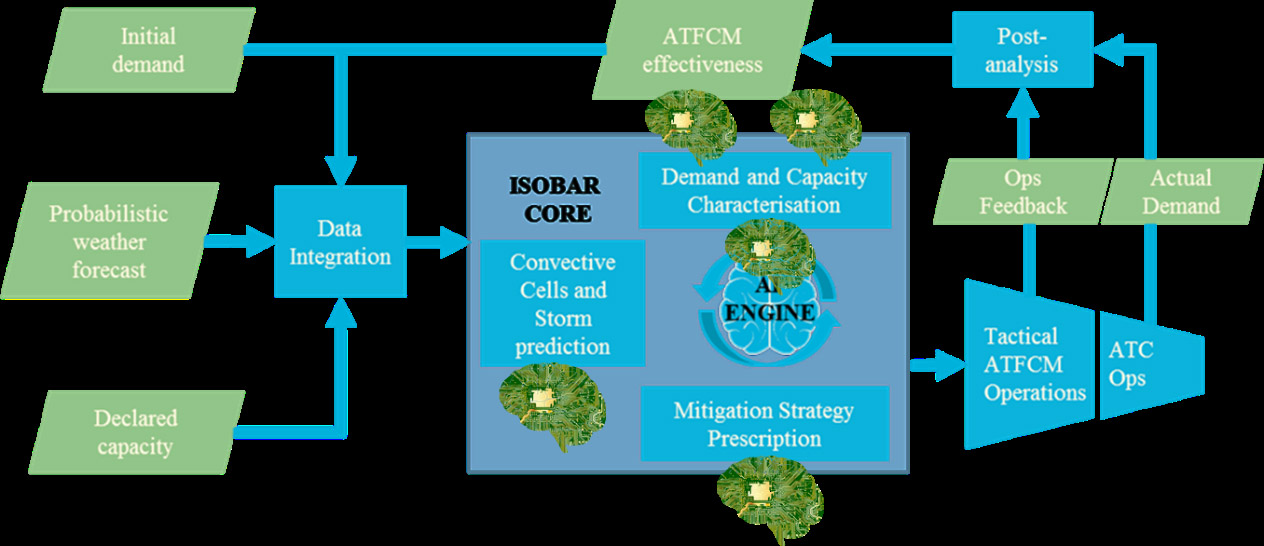
In normal times, weather is one of the principal causes of flight delays, which comes at a significant cost not just for the passenger but also airports and airlines. A recently-started SESAR JU project aims to show how artificial intelligence solutions can help predict stormy weather, leading to better planning and traffic predictability, as Marta Sánchez Cidoncha, ISOBAR project coordinator from CRIDA, explains.
What are the rationale and main objectives of the project?
The main objective of ISOBAR is to design a service that supports flow management in the analysis and mitigation of convective storms or thunderstorms. In more detail, the project focusses its research in four key aspects that need a boost:
-
Integration of dynamic weather cells in collaborative air traffic flow and capacity management (ATFCM) processes, both at pre-tactical and tactical timeframes and at local (flow management position/ local traffic manager (FMP/ local traffic manager) and network (Network Manager) levels.
-
More precise characterisation of demand and capacity imbalances relying on the processing of complex probabilistic weather products and ATM and weather data integration.
-
Prototyping a user-driven mitigation plan considering AUs priorities (and fluctuations in demand based on weather forecasts) and predicted effectiveness of ATFCM regulations, considering flow constraints and network effects.
-
Developing an operational and technical roadmap for the integration of ancillary services (providing AI-based hotspot detection and adaptative mitigation measures) into the Network Manager platform, by defining interfaces, functional and performance requirements.
Why is having accurate weather forecasting so important to network operations?
On average weather accounts for roughly one-third of ATFM delays (25% for en-route and ~50% for the airports). Examining only the top ten days with highest delays due to weather regulations from the first half of 2018, strong convective activity throughout Europe was the principal cause, with estimated cost due to airport and en-route delays reaching almost €130 million (roughly 10% of the weather delay in 2018 concentrated in only 10 days). Given these large cost figures, even minor improvement in prediction and performance of ATFM operations during significant convective weather events will yield to substantial yearly savings for the ATM system.
However, network prediction and performance are very sensitive to weather and the uncertainty in its prediction, thereby the challenge.
What are the shortcomings with the current integration of weather data into the network operations plan?
First, there is still a gap in understanding between meteorologists and different ATM stakeholders. This makes it difficult for them to recognise their mutual needs, the limitations they are facing, and the context in which they operate. ISOBAR aims to contribute to bridging this gap.
Second, there is a lack of weather forecasting capabilities when it comes to predicting convective phenomena in advance, meaning in timeframes compatible with ATFCM tactical and pre-tactical processes. Meteorological offices are moving towards increasing both the spatial and temporal resolution in their forecasts (which is required to capture the preconditions for the existence of a thunderstorm), and ISOBAR is working on connecting the dots to make the benefits available at flow management positions.
How are you using data/AI in your project? What type of data is needed? How are you using AI and machine learning to improve the system?
We are using data to build machine-learning methods, essentially neural networks, in support of various engines of the ISOBAR solution.

We are using data to characterise the demand side (flight plans, actual flights, etc.), the capacity side (sectors, declared capacities, regulations, etc.) and the behaviour of the atmosphere (weather predictions, thunderstorm observation). Hotspot detection is also enriched with the analysis of historical data. Finally, the support tool proposing and ranking mitigation plans is fed back by the post-operational analysis of ATFCM measures effectiveness.
All in all, we use data from airlines/dispatchers, ANSPs, Meteorological offices and the Network Manager.
How will you test your research/solution? Could it be commercialised?
The project includes the prototyping of an air traffic flow management support service and the testing of the innovative functionalities via simulation, by connecting the prototypes to the Network Manager INNOVE platform (the air traffic flow management real-time simulator for the validation of Network Management solutions).
With further development, ISOBAR prototypes will shape up into an operational set of AI engines framed in a SWIM ancillary service. There is already an on-going initiative to provide to Enaire, the Spanish ANSP, a support tool for the better integration of advance convective weather products into the FMP.
What benefits do you hope your project will bring?
The project results are expected to improve convective weather forecasts, anticipate the detection of demand capacity imbalances in the network and provide optimal mitigation solutions. This means better situational awareness of the operating environment, which at the day, means better decision-making all around!
The project brings together researchers from across Europe: Centro de Referencia de Investigación, Desarrollo e Innovación ATM, A.I.E. (CRIDA); Universidad Carlos III de Madrid; Cranfield University; Ecole Nationale de l Aviation Civile ; Direction Générale de l’Aviation Civile/Direction des Services de la Navigation Aérienne ; Meteo-France; Agencia Estatal de Meteorología; Sopra Steria Group; Earth Networks; Swiss International Air Lines AG; and Eurocontrol.
The project has received funding from the SESAR Joint Undertaking within the framework of the European Union's Horizon 2020 research and innovation programme under grant agreement No 891965
